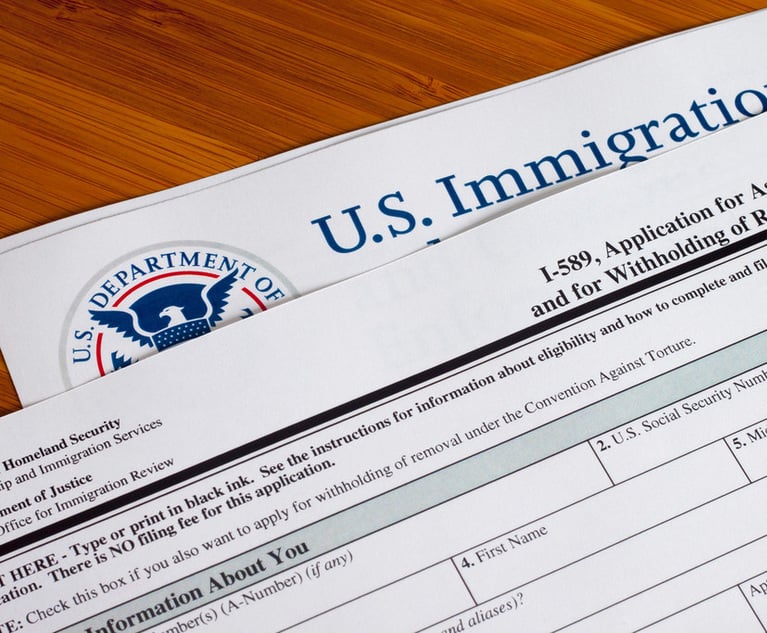Prohibition and the Future of Marijuana in Connecticut
Despite the surging momentum in favor of legalization, there remains a federal prohibition on both the medical and recreational use of marijuana.
August 27, 2018 at 04:52 PM
7 minute read
 Marijuana is currently legal for medicinal use in Connecticut. Photo: Shutterstock
Marijuana is currently legal for medicinal use in Connecticut. Photo: Shutterstock
The legalization of marijuana appears to have passed the point of no return. Medical marijuana use is legal in 31 states, including Connecticut, and 15 other states allow medical use of cannabis products with a limited THC content. The recreational use of marijuana is now legal in nine states plus the District of Columbia. According to the most recent public opinion polls by Pew Research Center and Quinnipiac University, 61 to 63 percent of American voters support legalization of recreational marijuana, whereas just 33 to 37 percent oppose it—the greatest level of support ever measured.
Despite the surging momentum in favor of legalization, there remains a federal prohibition on both the medical and recreational use of marijuana. As a Schedule I drug under the Controlled Substance Act, marijuana is classified as a drug with no currently accepted medical use and a high potential for abuse. This harsh stance maintained by federal government is a striking corollary to the prohibition of alcohol from 1920 to 1933. The prohibition of alcohol made it a hot commodity on the black market, turning it into a lucrative and tax-free business opportunity and giving rise to national crime syndicates headed by the likes of Al Capone and Charles “Lucky” Luciano. Prohibition of alcohol accomplished nothing. Alcohol consumption continued, the black market thrived and liquor consumption was not quelled, particularly among young people. The 1933 passage of the 21st Amendment repealed the prohibition enacted by the 18th Amendment, handing over the authority to the states.
This is a familiar story to anyone keeping tabs on the marijuana industry because it is analogous. The Cole Memorandum issued under the Obama administration instructed U.S. attorneys not to expend limited federal resources in prosecuting persons complying with state marijuana law, largely deferring to each state's decision on marijuana legalization. Although this memorandum was since rescinded by U.S. Attorney General Jeff Sessions under the Trump administration, President Donald Trump has promised support of a “federalism-based legislative solution to this states' rights issue.” Furthermore, the Rohrabacher-Farr amendment prohibits the Department of Justice from using federal funds to interfere with individuals complying with state medical marijuana laws.
It seems inevitable that an end to the federal marijuana prohibition will soon follow and that the authority to regulate the industry will be vested in the states. States that have legalized recreational marijuana use have seen staggering tax revenues from marijuana sales and excise taxes, in some cases dwarfing the tax collected on sales of alcohol. While the state of Connecticut is not among the states that have legalized recreational marijuana, it has enacted a relatively robust and extensively regulated medical marijuana program. In doing so, the Connecticut Legislature has established numerous barriers to entry for a businesses to enter the industry. Namely, producers (growers) are required to post a $2 million surety bond; warehouses must be secured to a level on par with a bank; dispensary licenses may only be awarded to full-time licensed pharmacists; and any financial backer must undergo a full disclosure of background information and a character and fitness evaluation.
Given the parallels to alcohol described above, it should come as no surprise that Connecticut's medical marijuana program is replete with similarities to its liquor control program. The Department of Consumer Protection administers licensing to both medical marijuana and package stores, and as a result, even the applications for each are similar. One can therefore easily reach the conclusion that Connecticut's eventual recreational marijuana laws will take the form of a hybrid between the medical marijuana laws and the package store liquor license laws. There will surely be some elements of the medical marijuana program that are retained, such as security requirements, but there are aspects of the liquor license laws that should also be retained to protect the industry, allow the entry of smaller, local, entrepreneurs, and to retain the state of Connecticut's control over the recreational marijuana industry.
A small number of large holding companies have been gradually building an empire in the marijuana sector, acquiring smaller licensed marijuana businesses and pushing out the smaller local players. The phenomenon can be observed with greater clarity in Canada, where medical marijuana has been legal at the federal level since 2001 and recreational marijuana was legalized at the federal level in June of 2018. The federal legal status has allowed Canadian corporations to be publicly traded in the stock market. Two of the largest Canadian marijuana corporations, Canopy Growth Corp. and Aurora Cannabis, have respective market caps of $5.51 billion and $3.28 billion, whereas the largest among the American corporations, Terra Tech Corp. and Kush Bottles, have only achieved respective market caps of $122.98 million and $342.79 million. The future of the medical marijuana industry in the United States will follow the same path, leaving just a handful of multibillion-dollar holding companies with a monopoly on the entire industry, unless steps are taken at the state level to discourage big business from seizing control of the fledgling marijuana industry before it becomes too late.
Where a major motivation behind legalization is the tax revenue that states will collect from legal marijuana sales, it is also important that the after-tax revenue generated from those sales stays within the states where it will be reinvested in the local community by small businesses, and thereby grow the economy, especially in states such as Connecticut where growth is sorely needed, instead of being relocated outside of the state and perhaps the country to shelter it from further taxes or distributed to corporate shareholders as dividends.
One potential solution, which has been applied effectively in the area of liquor licenses, is the limitation of the number of licenses a person may pursue. Connecticut General Statute Section 30-48a sets forth this limit for alcoholic beverage retail permits, limiting the number of permits a person or backer may pursue to five (this number was previously set at two, but was increased through amendments in 2012 and 2015 such that it is now five). The definition of person or backer includes legal entities, and the definition of interest includes any interest, controlling or not controlling, held by a person or member(s) of that person's family, or a legal entity controlled by that person or that person's family member(s). Thus, it is difficult to circumvent the limitation by having the permit issued in the name of a family member, a trust, corporation, or company and so on.
An analogous limitation does not currently exist with regard to medical or recreational marijuana licenses, but it would be wise for Connecticut lawmakers to enact one. As it presently stands, the DCP is required to assess the qualifications and character and fitness of any financial backer of a marijuana dispensary facility with at least 5 percent ownership of the applicant or which exercises control over the applicant. The DCP is not, however, authorized to deny licensure to an applicant solely on the basis that the applicant is backed by a corporation with an ownership interest in several other dispensary facilities or producers within Connecticut or elsewhere. This limitation must be enacted to protect Connecticut's small businesses before—and if—recreational marijuana becomes legal in Connecticut or at the federal level.
Nicholas Paindiris and Ian Butler are with Brown Paindiris & Scott in Glastonbury.
This content has been archived. It is available through our partners, LexisNexis® and Bloomberg Law.
To view this content, please continue to their sites.
Not a Lexis Subscriber?
Subscribe Now
Not a Bloomberg Law Subscriber?
Subscribe Now
NOT FOR REPRINT
© 2025 ALM Global, LLC, All Rights Reserved. Request academic re-use from www.copyright.com. All other uses, submit a request to [email protected]. For more information visit Asset & Logo Licensing.
You Might Like
View All
Settlement Allows Spouses of U.S. Citizens to Reopen Removal Proceedings
4 minute read
DOJ, 10 State AGs File Amended Antitrust Complaint Against RealPage and Big Landlords
4 minute read
New Teeth for Anti-SLAPP Statute? Absolute Immunity for Union Grievance Proceedings
2 minute readTrending Stories
- 1Decision of the Day: Judge Dismisses Defamation Suit by New York Philharmonic Oboist Accused of Sexual Misconduct
- 2California Court Denies Apple's Motion to Strike Allegations in Gender Bias Class Action
- 3US DOJ Threatens to Prosecute Local Officials Who Don't Aid Immigration Enforcement
- 4Kirkland Is Entering a New Market. Will Its Rates Get a Warm Welcome?
- 5African Law Firm Investigated Over ‘AI-Generated’ Case References
Who Got The Work
J. Brugh Lower of Gibbons has entered an appearance for industrial equipment supplier Devco Corporation in a pending trademark infringement lawsuit. The suit, accusing the defendant of selling knock-off Graco products, was filed Dec. 18 in New Jersey District Court by Rivkin Radler on behalf of Graco Inc. and Graco Minnesota. The case, assigned to U.S. District Judge Zahid N. Quraishi, is 3:24-cv-11294, Graco Inc. et al v. Devco Corporation.
Who Got The Work
Rebecca Maller-Stein and Kent A. Yalowitz of Arnold & Porter Kaye Scholer have entered their appearances for Hanaco Venture Capital and its executives, Lior Prosor and David Frankel, in a pending securities lawsuit. The action, filed on Dec. 24 in New York Southern District Court by Zell, Aron & Co. on behalf of Goldeneye Advisors, accuses the defendants of negligently and fraudulently managing the plaintiff's $1 million investment. The case, assigned to U.S. District Judge Vernon S. Broderick, is 1:24-cv-09918, Goldeneye Advisors, LLC v. Hanaco Venture Capital, Ltd. et al.
Who Got The Work
Attorneys from A&O Shearman has stepped in as defense counsel for Toronto-Dominion Bank and other defendants in a pending securities class action. The suit, filed Dec. 11 in New York Southern District Court by Bleichmar Fonti & Auld, accuses the defendants of concealing the bank's 'pervasive' deficiencies in regards to its compliance with the Bank Secrecy Act and the quality of its anti-money laundering controls. The case, assigned to U.S. District Judge Arun Subramanian, is 1:24-cv-09445, Gonzalez v. The Toronto-Dominion Bank et al.
Who Got The Work
Crown Castle International, a Pennsylvania company providing shared communications infrastructure, has turned to Luke D. Wolf of Gordon Rees Scully Mansukhani to fend off a pending breach-of-contract lawsuit. The court action, filed Nov. 25 in Michigan Eastern District Court by Hooper Hathaway PC on behalf of The Town Residences LLC, accuses Crown Castle of failing to transfer approximately $30,000 in utility payments from T-Mobile in breach of a roof-top lease and assignment agreement. The case, assigned to U.S. District Judge Susan K. Declercq, is 2:24-cv-13131, The Town Residences LLC v. T-Mobile US, Inc. et al.
Who Got The Work
Wilfred P. Coronato and Daniel M. Schwartz of McCarter & English have stepped in as defense counsel to Electrolux Home Products Inc. in a pending product liability lawsuit. The court action, filed Nov. 26 in New York Eastern District Court by Poulos Lopiccolo PC and Nagel Rice LLP on behalf of David Stern, alleges that the defendant's refrigerators’ drawers and shelving repeatedly break and fall apart within months after purchase. The case, assigned to U.S. District Judge Joan M. Azrack, is 2:24-cv-08204, Stern v. Electrolux Home Products, Inc.
Featured Firms
Law Offices of Gary Martin Hays & Associates, P.C.
(470) 294-1674
Law Offices of Mark E. Salomone
(857) 444-6468
Smith & Hassler
(713) 739-1250











